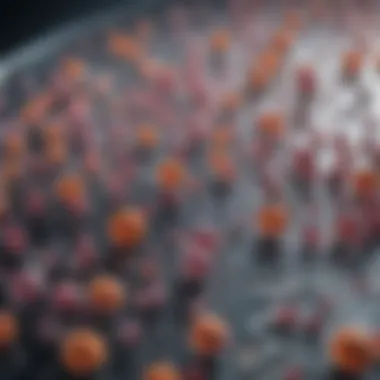Cell Doctor for a Day: Unraveling Cellular Repair


Intro
The study of cellular repair mechanisms is increasingly becoming vital in understanding health and disease. As the building blocks of life, cells do not only carry out fundamental functions but also maintain their integrity amidst various stresses. The concept of being a 'cell doctor' for a day implies an in-depth look at how cells can be nurtured and healed. This article sets out to explore these cellular processes, focusing on the intricate mechanisms that support cellular health and longevity.
Cellular repair mechanisms involve various biological pathways and systems. These systems enable cells to respond effectively to damage caused by environmental factors, oxidative stress, or disease conditions. A comprehensive understanding of these processes can provide insights into not just individual cellular health but also on how these dynamics affect the organism as a whole.
In this article, we aim to dissect key findings from current research, shedding light on how advancements in cell biology can enhance life at a microscopic level.
Preface to Cellular Repair
Cellular repair is an essential aspect of biology that significantly influences overall health. Understanding how cells repair themselves can shed light on various diseases and aging processes. As cells undergo wear and stress, they must maintain their structural and functional integrity. This process is not only vital for individual cells but also for the organism as a whole. The maintenance of cellular health ensures optimal functionality, allowing tissues and organs to perform their tasks effectively.
Defining Cellular Repair
Cellular repair refers to the mechanisms that restore the integrity and function of cells after damage. Damage to cells can arise from various sources including environmental stressors, pathogens, or genetic defects. Some critical repair mechanisms include DNA repair, protein quality control, and membrane repair. Each of these processes addresses specific types of damage, illustrating the complexity of cellular functions.
For instance, DNA repair mechanisms can detect and correct errors that occur during DNA replication or due to external factors like radiation. Protein quality control systems, such as chaperones, help ensure that proteins are properly folded and functional. If a protein becomes misfolded, the system can refold it or target it for degradation. Similarly, membrane repair processes ensure that damage to the cell membrane is swiftly addressed to maintain cellular homeostasis.
Importance of Cellular Health
Cellular health is paramount for the well-being of an organism. Healthy cells contribute to the proper functioning of tissues and organs, preventing disease and prolonging life. The role of cellular repair mechanisms cannot be overstated. They are the frontline defense against cellular dysfunction caused by stress or damage.
A compromised cellular repair system can lead to accumulation of damaged molecules, contributing to diseases such as cancer, neurodegenerative disorders, and age-related ailments. Hence, understanding cellular repair not only aids in comprehending the basic mechanisms of life but also has significant implications for medical research and therapeutic interventions.
In summary, exploring the realm of cellular repair provides invaluable insights into how organisms maintain their vitality and respond to challenges, paving the way for advancements in health and medicine.
"The ability of cells to repair themselves is critical for life. Without it, organisms would not survive long in a changing environment."
Through the lens of cellular repair, we can deepen our understanding of life at the molecular level, enhancing our approaches in treating diseases and promoting health.
Fundamental Biology of Cells
Understanding the fundamental biology of cells is crucial for comprehending how cellular repair mechanisms function. Cells are the basic building blocks of all living organisms. Examining their structure and processes provides insights into cellular health, its vulnerabilities, and the ways to enhance repair mechanisms. This section explores the primary components of cells and how they operate, laying a foundation for understanding cellular repair.
Basic Cell Structure
Cell structure is essential for realizing the capabilities each cell possesses. Cells have different structures based on their functions, but they share several common components. The main parts include:
- Cell Membrane: This semi-permeable barrier controls what enters and exits the cell, maintaining internal conditions.
- Cytoplasm: A gel-like substance where biochemical processes occur and organelles are suspended.
- Nucleus: Contains genetic material (DNA) and directs cellular activities, including growth and replication.
- Organelles: Specialized structures like mitochondria, endoplasmic reticulum, and Golgi apparatus perform distinct roles vital for cell function.
These structural components are interdependent. Damage or dysfunction in one part can lead to broader cellular issues, emphasizing the importance of effective repair mechanisms.
Cellular Functions and Processes
Cellular functions encompass a range of activities necessary for survival. These include:
- Metabolism: The sum of all chemical reactions within the cell, providing energy and building blocks for growth.
- Cell Signaling: Cells communicate through signaling pathways, influencing behavior and coordinating functions.
- Cell Division: Both mitosis and meiosis are critical for growth, tissue repair, and reproduction. Proper regulation ensures cellular health.
Efficient execution of these functions is vital for an organism's overall well-being. When cellular processes are disrupted, the need for repair becomes pressing. This nexus with repair underscores the importance of understanding cellular functions deeply.
Types of Cells in Multicellular Organisms
Multicellular organisms consist of various cell types, each adapted for specific functions. The major categories include:
- Epithelial Cells: Form protective barriers and are involved in secretion and absorption.
- Muscle Cells: Specialized for contraction and movement.
- Nerve Cells (Neurons): Facilitate communication and signaling throughout the body.
- Blood Cells: Include red and white blood cells, essential for transport and immune responses.
Each type plays a unique role in maintaining the organism's homeostasis. Understanding these diverse cell types helps in recognizing how specific repair mechanisms are activated when damage occurs.
Understanding the fundamental biology of cells is the first step towards appreciating the complexities of cellular repair.
In summary, the fundamental biology of cells establishes a context for cellular repair mechanisms. Recognizing how cells are structured, what functions they perform, and the types of cells present in an organism makes clear the need for effective repair systems in maintaining health.
Mechanisms of Cellular Repair
The mechanisms of cellular repair are central to maintaining the integrity and functionality of cells in all living organisms. These processes are critical to counteracting damage caused by various factors such as environmental stress, aging, and metabolic byproducts. Understanding these mechanisms not only underscores their importance for cellular health but also highlights potential interventions in disease contexts. The effective operation of these mechanisms is essential for the longevity and proper function of tissues and organs, impacting overall organism health.


DNA Repair Mechanisms
DNA repair mechanisms are crucial for correcting errors and damage that can occur in the genetic material of cells. Cells are constantly exposed to various sources of DNA damage, including both endogenous factors, like metabolic activities, and exogenous factors, such as UV radiation or toxins. There are several core repair systems in place:
- Base Excision Repair (BER): This pathway fixes small, non-helix-distorting base lesions resulting from factors like oxidative stress.
- Nucleotide Excision Repair (NER): This mechanism deals with bulky DNA adducts, primarily those caused by UV light.
- Mismatch Repair (MMR): This system corrects errors during DNA replication, ensuring that the correct nucleotides are incorporated into the DNA strand.
- Homologous Recombination and Non-Homologous End Joining (NHEJ): These pathways repair double-strand breaks in DNA, which can be catastrophic for the cell if left unrepaired.
The effectiveness of these mechanisms is a determining factor in the cell’s ability to avoid mutations, which can lead to cancer or other genetic diseases. By understanding DNA repair pathways, researchers can develop therapies to enhance these processes, presenting a vital area for future exploration.
"Understanding DNA repair is key not only for the prevention of diseases but also for the enhancement of health through regenerative medicine."
Protein Quality Control
Protein quality control is essential for maintaining cellular function and preventing the accumulation of damaged or misfolded proteins. Cells employ several strategies to manage protein integrity, which include:
- Chaperone Proteins: These assist in proper protein folding and prevent aggregation of misfolded proteins.
- Proteasomes: Specific enzymes that degrade unneeded or damaged proteins, thus maintaining cellular balance.
- Autophagy: A process where cells degrade and recycle cellular components, including defective proteins.
These mechanisms play a key role in preventing proteotoxic stress, which can result in cell dysfunction and contribute to age-related diseases. Advancements in understanding how these processes work provide opportunities to develop therapies aimed at enhancing protein homeostasis, making this an area of significant research interest.
Cell Membrane Repair Processes
Cell membrane integrity is vital for cell survival and function. When cells experience damage to their membranes, they must act quickly to repair the defects. Mechanisms involved in cell membrane repair include:
- Calcium-Dependent Exocytosis: This rapid response mechanism allows the insertion of new membrane material into the damaged areas, thereby sealing breaches.
- Lipid Repair Pathways: Cells initiate specific pathways to regenerate phospholipids, which are crucial for restoring membrane structure after injury.
- Endosome-Mediated Repair: This involves the use of internal vesicles to patch damaged areas on the membrane.
Research into these repair processes is important as membrane integrity is closely tied to cell signaling, nutrient uptake, and protection against pathogens. By enhancing our understanding of how cells repair their membranes, new therapeutic strategies can be developed to prevent cell death and promote tissue repair.
Cellular Response to Stress
Understanding cellular response to stress is crucial in the context of cellular repair mechanisms. Cells constantly face various stressors that can disrupt their functionality. Managing these stressors effectively is pivotal for maintaining cellular integrity and organism health. This section will highlight the types of cellular stress, the process of autophagy as a defense mechanism, and the overall impact of stress on cellular functionality.
Types of Cellular Stress
Cells experience several types of stress, each impacting their health in different ways. Common types include:
- Oxidative Stress: This occurs when there is an imbalance between free radicals and antioxidants in the body. Excess free radicals can damage cellular components, including DNA, proteins, and membranes.
- Nutritional Stress: A lack of essential nutrients can impede cellular processes. This stress can lead to a decrease in cellular repair capabilities and overall functionality.
- Mechanical Stress: Cells can also face physical stress from their environment, such as stretching or compression, especially in tissues like muscle.
- Thermal Stress: Extreme temperatures can affect cellular structure, leading to denaturation of proteins and disruption of membranes.
- Chemical Stress: Exposure to toxic substances can impair normal cellular operations, leading to cell death or malfunction.
Awareness of these stress types helps in understanding how cells respond and adapt, guiding research on enhancing cellular resilience.
Autophagy: A Cellular Defense Mechanism
Autophagy is a vital cellular process where cells degrade and recycle components through lysosomal machinery. It serves multiple purposes:
- Removal of Damaged Organelles: Autophagy helps eliminate malfunctioning organelles, thereby preventing potential harm to the cell.
- Protein Quality Control: Misfolded or aggregated proteins can be detrimental. Autophagy ensures these are broken down and recycled.
- Nutrient Recycling: During stress, autophagy can break down cellular components to provide essential nutrients, sustaining cellular operations.
- Pathogen Defense: This mechanism also plays a role in destroying intracellular pathogens, contributing to immune responses.
"Autophagy is an essential mechanism for maintaining cellular homeostasis, especially under stress conditions."
The significance of autophagy cannot be overstated, as it directly correlates with cellular survival and function under stress.
Impact of Stress on Cellular Functionality
Stress can severely affect cellular functionality. The consequences are varied and can lead to:
- Impaired Cell Growth: Prolonged stress can inhibit proper cell division and growth. This can affect tissue regeneration and healing.
- Increased Cell Death: Excessive stress often leads to apoptosis or necrosis, resulting in loss of healthy cells.
- Inflammation: Chronic cellular stress can trigger inflammatory pathways, leading to further tissue damage and disease progression.
- Altered Communication: Stress can disrupt signaling pathways, hindering normal intercellular communication and coordination.
In summary, the ability of cells to respond to stress is not just about survival; it is crucial for maintaining overall cellular health and, by extension, the health of the entire organism. Understanding these responses is critical for devising interventions in diseases where cellular repair mechanisms fail.
Advancements in Cellular Repair Research
The exploration of advancements in cellular repair research holds significant importance in understanding cellular dynamics and their broader implications for health and disease. This field continuously evolves, driven by innovative technologies and methodologies that aim to enhance cellular repair mechanisms. As we delve into this topic, it is crucial to consider specific elements such as gene editing, stem cell applications, and regenerative medicine approaches, each contributing uniquely to our ability to repair and maintain cellular health. The benefits of these advancements can lead to improved therapeutic strategies that offer hope in previously insurmountable medical challenges.
Gene Editing Technologies
Gene editing technologies have revolutionized the landscape of cellular repair research. Techniques like CRISPR-Cas9 offer the ability to make precise alterations to the DNA sequence within living organisms. This capability allows researchers to correct genetic defects, and restore normal cellular functions. The significance of gene editing extends beyond merely fixing errors; it opens avenues for synthesizing therapeutic proteins that may be deficient in certain diseases.
Key benefits of gene editing technologies include:
- Targeted Therapy: Ability to focus on specific genes, improving treatment efficacy.
- Reduced Off-target Effects: Advances in precision editing reduce unintended genetic changes.
- Potential to Treat Genetic Disorders: Diseases like cystic fibrosis and sickle cell anemia may be manageable with gene edits.


However, ethical considerations surround gene editing technologies. Discussions about potential misuse and the implications of germline modifications remain ongoing. Addressing these concerns is essential to guide responsible research and application in clinical settings.
Stem Cell Therapy
Stem cell therapy represents another significant advancement in cellular repair research. Stem cells are unique in their ability to differentiate into various cell types, making them invaluable in regenerative medicine. Scientists harness stem cells to understand cellular repair mechanisms, leading to innovative treatments for conditions such as spinal cord injuries and neurodegenerative diseases.
Some remarkable aspects of stem cell therapy include:
- Versatility: Stem cells can be tailored to match patient needs, diminishing the risk of rejection.
- Regeneration of Damaged Tissues: Possibility to regenerate heart, liver, or advanced tissue damage.
- Clinical Trials: Ongoing trials test stem cell efficacy across a range of disorders, highlighting its potential.
Still, challenges exist, such as ensuring the safety and effectiveness of stem cell treatments. The quest for optimal sources and protocols continues as researchers work toward standardizing stem cell therapies for clinical use.
Regenerative Medicine Approaches
Regenerative medicine encompasses a broad spectrum of strategies to repair or replace damaged tissues or organs. This field combines biology, chemistry, material science, and engineering, aiming to restore normal function through tissue engineering and the manipulation of cellular mechanisms. Approaches in regenerative medicine often involve using biomaterials and growth factors to support tissue repair.
Prominent approaches in regenerative medicine include:
- Tissue Engineering: Creating bioengineered tissues for transplantation.
- Growth Factor Applications: Utilizing factors that promote healing and regeneration.
- 3D Bioprinting: Innovative technology that structures cells and biomaterials to create functional tissues.
Regarding regenerative medicine, the collaboration between various disciplines enhances the potential for breakthroughs.
In summary, the advancements in cellular repair research through gene editing technologies, stem cell therapy, and regenerative medicine approaches offer promising pathways for medical science. As our understanding deepens, it is essential to maintain ethical standards and address challenges, ensuring these innovations improve quality of life and health outcomes for individuals.
Impact of Cellular Repair on Aging
The exploration of how cellular repair affects aging is essential in understanding not just the science of life but the fundamental aspects of how we maintain our health over time. As cells undergo countless division and repair processes, they encounter numerous stresses that can impair their function. The efficiency of cellular repair mechanisms directly influences how we age and our susceptibility to age-related diseases.
Cellular repair encompasses various processes, including DNA repair, protein quality control, and cellular rejuvenation. Each of these processes plays a critical role in maintaining cellular integrity. As we age, the efficiency of these mechanisms gradually declines. Understanding this decline can help illuminate ways to mitigate or even reverse some effects of aging.
A notable factor in aging is cellular senescence. This process involves cells that cease to divide but do not die. Instead, senescent cells can influence their surrounding environment, often resulting in chronic inflammation. This inflammatory response is linked to several age-related illnesses, such as cardiovascular disease and neurodegenerative disorders. By studying ways to target or eliminate senescent cells, researchers are looking for strategies that could improve health during aging.
Another crucial element is the function of telomeres. These structures cap the end of chromosomes and protect them from degradation. Each time a cell divides, telomeres become shorter. Eventually, when they reach a critical length, the cell can no longer divide and becomes senescent or enters apoptosis. By maintaining or extending telomeres, we may extend cellular longevity, thus providing insights into combating age-related decline.
"The potency of cellular repair mechanisms remains a pivotal area of research that could redefine aging and health in the future."
The ongoing research into the influence of cellular repair on aging not only helps in understanding disease mechanisms but also paves the way for innovative therapeutic approaches. With technologies advancing rapidly, the potential to harness these cellular processes could vastly improve overall health and longevity in the aging population.
Cellular Senescence
Cellular senescence is a phenomenon where cells enter a state of permanent growth arrest. This process can be triggered by various factors, including oxidative stress and DNA damage. Senescent cells can no longer replicate, which initially seems beneficial, as it prevents damaged cells from proliferating. However, they often secrete pro-inflammatory factors, known as the senescence-associated secretory phenotype (SASP), which can lead to tissue dysfunction.
Evidence suggests that the accumulation of senescent cells contributes significantly to aging and age-related diseases. Researchers are now focusing on developing therapies to eliminate these cells or mitigate their harmful effects. Strategies like senolytics—drugs that selectively induce death of senescent cells—are being explored as potential interventions to improve health and longevity.
The ability to clear senescent cells from tissues may not just extend lifespan but also enhance health span, which focuses on the quality of life and health during aging.
Role of Telomeres in Cellular Longevity
Telomeres play a crucial role in maintaining the health of chromosomes during cell division. Each time a cell divides, telomeres shorten, making them a biomarker of cellular aging. When telomeres become critically short, it triggers cellular senescence or apoptosis, limiting the number of divisions a cell can undergo.
Research in the field of telomere biology has led to the understanding that maintaining telomere length can potentially reverse age-related decline in cellular function. Some studies suggest that telomerase, an enzyme that can lengthen telomeres, may play an important role in promoting longevity. By enhancing telomerase activity in somatic cells, it might be possible to stave off some effects of aging. However, it is essential to approach this potential cautiously, as uncontrolled telomerase activation could increase the risk of tumorigenesis.
In summary, understanding the role of cellular repair, particularly through mechanisms like senescence and telomere length, offers promising avenues for addressing not just the aging process itself but also broader health implications as populations continue to age.
Ethical Considerations in Cellular Repair Research
In the realm of cellular repair research, ethical considerations play a crucial role. As scientists and researchers strive to enhance cellular health and longevity through innovative techniques, they must navigate complex ethical landscapes. This section explores these important issues to provide insight into how ethical practices shape cellular repair research and its applications.
Ethics of Gene Editing
Gene editing technologies, such as CRISPR-Cas9, have revolutionized biological research by enabling precise alterations to an organism's DNA. However, these advancements come with significant ethical dilemmas, particularly concerning human germline editing. This form of gene editing, which alters the DNA passed on to future generations, provokes serious moral questions regarding consent, potential unintended consequences, and the possibility of 'designer babies.' Therefore, the ethical implications are not just theoretical; they have practical consequences for society at large. Researchers must consider factors such as:
- Informed Consent: Patients must be fully informed about the potential risks and benefits of gene editing.
- Equity and Access: Ensuring that these technologies are accessible to all, rather than a select few, is vital for social equity.
- Long-term Effects: Understanding how modifications might affect future generations is essential to ethical stewardship.
Thus, careful deliberation on such topics creates a responsible framework for utilizing gene editing technologies in cellular repair applications.


Regulatory Frameworks
To address the ethical challenges of cellular repair research, regulatory frameworks are implemented. These frameworks aim to establish standards for the responsible conduct of research and to protect the rights and welfare of individuals involved. Regulatory bodies, such as the Food and Drug Administration (FDA) in the United States, oversee the application of new technologies, ensuring that they adhere to safety and efficacy standards.
In addition to national oversight, international guidelines also play a role. The World Health Organization (WHO) and other organizations provide guidelines for ethical research practices that transcend borders. Important elements of these frameworks include:
- Oversight Committees: These bodies review research proposals to ensure ethical compliance before experiments commence.
- Transparency in Research: Researchers should publish findings and disclose conflicts of interest to maintain public trust.
- Public Engagement: Involving the public in discussions about emerging technologies can inform policies and guide ethical standards.
"Establishing comprehensive regulatory frameworks is essential for the sustainable development of cellular repair technologies."
The overarching importance of ethical considerations cannot be overstated. As cellular repair research advances, maintaining a balance between innovation and ethics will be crucial for fostering public trust and ensuring that the benefits of such technologies reach society as a whole.
Practical Applications of Cellular Repair
The practical applications of cellular repair are essential corners of modern medicine and science. These applications aim to harness the inherent mechanisms of repair within cells for therapeutic purposes. Understanding these applications can inform better treatment protocols and potentially enhance patient outcomes.
Clinical Implications
Cellular repair has significant clinical implications that impact various health conditions. By utilizing the cellular mechanisms of repair, medical professionals aim to address a range of diseases. The potential of regenerative medicine lies in its ability to rejuvenate tissues and organs that suffer from damage. For instance, in diseases like diabetes, where the pancreatic cells are compromised, therapies that promote cellular regeneration could restore insulin production.
Additionally, understanding how cells repair themselves opens avenues to combat critical issues like cancer. Targeting the pathways that facilitate DNA repair could lead to tailored cancer therapies. Cancers often exploit these pathways for their growth and survival. By inhibiting tumor cell's repair mechanisms, clinicians can increase the efficacy of chemotherapy and radiation treatments, allowing for better management of the disease. These approaches are particularly relevant in the field of personalized medicine, where treatments are tailored to the genetic profile of the patient's tumor.
"The manipulation of cellular repair mechanisms can redefine treatment strategies across various medical fields, from oncology to regenerative medicine."
Therapeutic Innovations
Therapeutic innovations stemming from a deeper understanding of cellular repair mechanisms are rapidly evolving. One notable advancement is the development of small molecules that can enhance or inhibit specific repair pathways. These molecules can serve to either promote repair in damaged tissues or block repair in cancer cells. The dual potential provides a platform for creating targeted therapies.
Moreover, gene therapy techniques, particularly CRISPR-Cas9, allow for the direct modification of genes associated with repair mechanisms. By correcting mutations that impair cellular repair, researchers aim to treat genetic disorders more effectively. This approach has shown promise in conditions like muscular dystrophy and certain inherited disorders.
Stem cell therapies also represent a major innovation in the field of cellular repair. Stem cells possess the ability to differentiate into various cell types, providing a source for generating new, healthy cells. This method offers potential for treating a variety of conditions, including neurodegenerative diseases and injuries. Advances in stem cell research can lead to applications that significantly enhance recovery processes in affected tissues.
In summary, the practical applications of cellular repair are vast and hold immense potential for future medical advancements. As research continues, the integration of cellular repair mechanisms into clinical practice will likely revolutionize how we approach the treatment of chronic diseases and injuries.
Future Directions in Cellular Repair Research
The field of cellular repair research is rapidly evolving, revealing new possibilities for enhancing cellular health and function. Understanding the future directions in this area is crucial, as these advancements can play a pivotal role in addressing various diseases and age-related conditions. This section explores interdisciplinary approaches and potential breakthroughs that could transcend existing boundaries in cellular repair mechanisms, providing insights into the significance of continuous research in this domain.
Interdisciplinary Approaches
The complexities of cellular repair necessitate collaboration across multiple scientific disciplines. Here are a few key areas that exemplify the importance of interdisciplinary approaches:
- Biotechnology: Advances in biotechnology, particularly in the development of tools like CRISPR-Cas9, have transformed the study of gene editing. This has implications for cellular repair, allowing for precise modifications to the DNA of cells.
- Bioinformatics: The integration of bioinformatics helps researchers analyze vast amounts of data generated through genomic studies. This aids in identifying patterns that could inform the repair pathways in different cell types.
- Materials Science: New biomaterials are being developed that can mimic cellular environments. These materials can be used to create scaffolds for tissue engineering, facilitating cellular repair in damaged tissues.
Collaboration enhances creativity and innovation. By merging expertise from various fields, new solutions for cellular repair challenges can arise.
The benefits of these interdisciplinary efforts are significant. They not only push the boundaries of existing knowledge but also foster a holistic understanding of how different factors affect cellular functions. Thus, these approaches can lead to improved therapies and interventions.
Potential Breakthroughs
As researchers continue to investigate cellular repair mechanisms, several potential breakthroughs are emerging, which may revolutionize how we approach health and disease. Some notable areas of focus include:
- Gene Therapy Enhancements: Developing more effective methods to deliver therapeutic genes directly to affected cells could lead to significant advancements in treating genetic disorders.
- Regenerative Medicine: The potential of stem cells to regenerate lost or damaged tissues remains a hot topic. Innovations in stem cell manipulation could lead to therapies that restore function significantly in various conditions like heart disease or spinal cord injuries.
- Nanotechnology: Utilizing nanomaterials to target and repair cells at a more precise level holds promise. These nanotechnologies could be designed to deliver drugs directly to damaged cells without affecting surrounding tissues.
Each breakthrough represents a step towards better understanding and enhancing cellular repair. For instance, advancements in gene therapy could shift the treatment paradigm for genetic disorders, making previously untreatable conditions manageable.
Ending: The Role of Cellular Repair in Health
Cellular repair mechanisms play a vital role in maintaining health and preventing diseases. Throughout this article, we explored how these processes ensure cellular integrity, which is essential for overall organism functionality. The importance of understanding cellular repair cannot be overstated, as it reveals pathways through which cells combat stresses, respond to damage, and ultimately contribute to longevity. Effective cellular repair mechanisms are essential not only for individual cells but also for the health of tissues and entire systems within the body.
Summary of Key Findings
In this article, several key findings have emerged regarding the mechanisms of cellular repair and their implications. First, we examined various repair pathways such as DNA repair and protein quality control. Each mechanism plays a critical role in preserving cell function by correcting damage and removing dysfunctional components. The processes of autophagy, highlighted as a cellular defense mechanism, underscore the importance of cellular clean-up activities in maintaining health. Research indicates that efficient cellular repair can significantly impact the aging process, with mechanisms like telomere maintenance being crucial for longevity.
Moreover, advancements in research, such as gene editing technologies and stem cell therapies, demonstrate promising prospects for enhancing these repair mechanisms. The possibility of interventions that promote cellular repair techniques opens new avenues in medical treatments and regenerative medicine.
Significance for Future Research
As we look to the future, the significance of cellular repair extends the boundaries of current biological knowledge. Understanding the underpinnings of cellular repair can greatly influence therapeutic strategies for various diseases. It also raises questions about developmental biology, personalized medicine, and longevity science.
Future research will benefit from interdisciplinary approaches, integrating insights from genetics, medicine, and bioengineering. This could lead to innovative ways to enhance cellular repair in medical practices. Additionally, ethical considerations surrounding gene editing and regenerative therapies must be addressed as this field evolves.
The exploration of cellular repair mechanisms thus remains a critical area for investigation, with the potential for significant breakthroughs that can advance our understanding of health and disease. By nurturing this research, we can foster a deeper comprehension of biological processes that directly influence our well-being.







